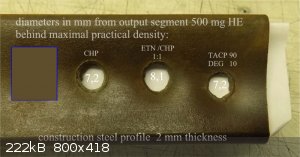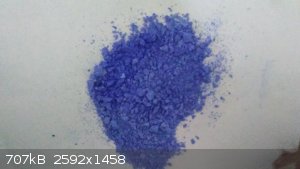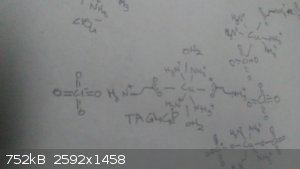| Pages:
1
2 |
Bfitzy
Harmless

Posts: 12
Registered: 8-7-2017
Member Is Offline
Mood: No Mood
|
|
Copper GABA Perchlorate
While reading about how copper would complex with organic amines such as hexamine and glycine, decided to try something else. I had gamma-aminobutyric
acid on hand and tried using that. The preparation was as follows:
To a weak solution of ammonia was added about 10g of ammonium perchlorate along with two copper electrodes. The cell was run for a few days at about
15 volts. Next was added approx. 3g of GABA(purchased from a health foods store for about $17/6oz). The cell was left to continue running for another
day, after which dark blue crystals began collecting at the electrides. These crystals we're collected and dried, and confinement tests with a couple
milligrams in Al foil showed a great deal of energy.
A friction and shock sensitivity test was performed with a hammer and around 100mg of CGAP (my current name for the compound: Copper GAba
Perchlorate). Under no conditions could I get it to detonate.
Anyone with advice, thoughts, questions et cetera is encouraged to comment.
|
|
|
Rosco Bodine
Banned
Posts: 6370
Registered: 29-9-2004
Member Is Offline
Mood: analytical
|
|
Freeform betaine could be neutralized with HNO3 and to the stirred hot betaine nitrate solution added in portions NH4ClO4. Betaine perchlorate should
crystallize out from a supernatant solution of byproduct NH4NO3.
|
|
|
Laboratory of Liptakov
International Hazard
    
Posts: 1387
Registered: 2-9-2014
Location: Technion Haifa
Member Is Online
Mood: old jew
|
|
TACP -CGAP
Tetraamine copper perchlorate (TACP) is good energetic material self. Without organics amines. But of course his properties are a better or even much
better with fuel- amines with which an easy create complex and takes their to self crystals. One from best is amino-guanidine, but of course is
possible using hexa - methylene - tetra - amine (hexamine) , glycine or some different orgnics amines. Preparation is usually pretty easy. In ammonia
water (10 -15% conc.) , is added for example 10g dry TACP + 10g organics amine. Glass container is closured and heated in water bath on 60 C to
dissolving both compounds. Right setting of ratios, same as ratio against ammonia water is necessary set for best yield (from crystallisation) and
properties of EM. But TACP takes organics amines into main complex always and easy. With hexamine is it confirmed in large span of ratios for example
2: 1 or 1:2. And result of properties are same. And the span conc. of hydroxide 10 - 25%. This is also your case. Works it almost self - auto -
reaction. Dont forget, that this solution is Schweizer reagent. He also dissolves all organics compounds. Therefore is impossible for separation using
paper filter. (contamination organics). And what. Your CGAP making some work ? Making the holes into steel ? Or some so something ? ..... ...LL ...LL
Development of primarily - secondary substances CHP (2015) Lithex (2022) Brightelite (2023) Nitrocelite and KC primer (2024)
|
|
|
Rosco Bodine
Banned
Posts: 6370
Registered: 29-9-2004
Member Is Offline
Mood: analytical
|
|
TACP decomposes on dissolution into plain water. For what I was describing using betaine, no copper is needed for complexation, as the plain amine
perchlorate by itself is interesting.
[Edited on 7/8/2017 by Rosco Bodine]
|
|
|
Laboratory of Liptakov
International Hazard
    
Posts: 1387
Registered: 2-9-2014
Location: Technion Haifa
Member Is Online
Mood: old jew
|
|
Our the answers (on GABA perchlorate) was walk cross over self in a short time.
Development of primarily - secondary substances CHP (2015) Lithex (2022) Brightelite (2023) Nitrocelite and KC primer (2024)
|
|
|
Bfitzy
Harmless

Posts: 12
Registered: 8-7-2017
Member Is Offline
Mood: No Mood
|
|
Have not had a chance to test it's effectiveness against steel. Unfortunately it is rather hot and dry where I live this time of year. Although I have
worked with general pyrotechnic compositions and flash powders before, I have no experience with high explosives. What are some good methods for
testing the substance? I.e. simple ways to make detonators/blasting caps with it?
|
|
|
Bfitzy
Harmless

Posts: 12
Registered: 8-7-2017
Member Is Offline
Mood: No Mood
|
|
Also I'm working with what I have on hand which isn't a ton. As I said GABA was the only amino acid on hand. Speaking of, is there anything else
copper will complex with other than nitrogenous substances? Right now I am mostly limited to copper Perchlorate salts and I don't have any hexamine.
|
|
|
Laboratory of Liptakov
International Hazard
    
Posts: 1387
Registered: 2-9-2014
Location: Technion Haifa
Member Is Online
Mood: old jew
|
|
On S-M is enough the study material how make detonators. If you will study threads and themes about it, early you will know enough, how to make any
detonator and how to testing. Studing is much safetely, than testing without knowledge. And according your questions, you need firstly study a lot
threads. Again I repeat. TACP is a good EM alone of self. Without anything. But his oxygen ballance is great + 14,5. Therefore is possible use
practically any fuel 1- 10 %. Accordingly OB. Cellulose, any nitrocellulose, hexamine, flour, sugars, alcoholic sugars, carbon, sulphur, black
powder, shotgun powder, oil, polyisobutylene, caramel and a lot next.
Result: Exploded it always..... ...LL ...LL
Development of primarily - secondary substances CHP (2015) Lithex (2022) Brightelite (2023) Nitrocelite and KC primer (2024)
|
|
|
Laboratory of Liptakov
International Hazard
    
Posts: 1387
Registered: 2-9-2014
Location: Technion Haifa
Member Is Online
Mood: old jew
|
|
Here you can study how seems the holes from different mixtures. Even also diethylene glycole is possible use as fuel for TACP. And results are in
basically identical against hexamine + TACP / called CHP. Slightly difference is, that CHP has the hole sharp edges from bottom, thus higher pressure
of detonation. But diameters are identical. Conditions of tests are of course identical for all 3 attempts. Dr.

[Edited on 9-7-2017 by Laboratory of Liptakov]
Development of primarily - secondary substances CHP (2015) Lithex (2022) Brightelite (2023) Nitrocelite and KC primer (2024)
|
|
|
PHILOU Zrealone
International Hazard
    
Posts: 2893
Registered: 20-5-2002
Location: Brussel
Member Is Offline
Mood: Bis-diazo-dinitro-hydroquinonic
|
|
Quote: Originally posted by Bfitzy  | While reading about how copper would complex with organic amines such as hexamine and glycine, decided to try something else. I had gamma-aminobutyric
acid on hand and tried using that. The preparation was as follows:
To a weak solution of ammonia was added about 10g of ammonium perchlorate along with two copper electrodes. The cell was run for a few days at about
15 volts. Next was added approx. 3g of GABA(purchased from a health foods store for about $17/6oz). The cell was left to continue running for another
day, after which dark blue crystals began collecting at the electrides. These crystals we're collected and dried, and confinement tests with a couple
milligrams in Al foil showed a great deal of energy.
A friction and shock sensitivity test was performed with a hammer and around 100mg of CGAP (my current name for the compound: Copper GAba
Perchlorate). Under no conditions could I get it to detonate.
Anyone with advice, thoughts, questions et cetera is encouraged to comment. |
You have Something moderately energetic because you have the perchlorate, the copper and complexating fuel...
Sadly is your fuel too present in proportion...as such overfuelled composition burns slower/deflagate less and detonates with much more difficulty...
Long story short...Oxygen Balance (OB) is too negative...
GABA is H2N-CH2-CH2-CH2-CO2H...(or C4H9NO2)
The NH2 is far enough from the acidic CO2H group to be basic enough and complexating....
1 mole C4H9NO2 needs 5,25 moles O2 to fully burn to H2O, N2 and CO2
2 C4H9NO2 + 10,5 O2--> 8 CO2 + 9 H2O +N2
Cu(ClO4)2 only afwords 4 O2 per mole or 3,5 O2 and 1 of Cl2
Cu(ClO4)2 --> CuCl2 + 4 O2
Cu(ClO4)2 --> CuO + 3,5 O2 + Cl2
Assuming the complex is tetracoordinated
Cu(H2N-C3H6-CO2H)4(ClO4)2
you have thus 4 GABA (that would need 4*5,25 O2 = 21 O2 to fully burn) for one Cu(ClO4)2 (that can only afword 4 O2)
==> You are thus lacking a lot of oxygen hence the crappy energetic results.
Working with lower molecular (less carbonaceous) amino acids will be beneficial...
Optimum being aminoglycollic acid H2N-CH2-CO2H (amino-acetic acid/glycine or if it was stable carbamic acid H2N-CO2H)...thus bringing OB from very
negative to closer to zero balance.
Working with multiple complexating amino groups into a single molecule is also a way to reduce the amount of aminated molecules into the complex and
thus the fuel % into the complex.
Cu(H2N-CH2-CH3)4(ClO4)2 = Cu(C2H7N)4(ClO4)2 = CuCl2N4O8-C8H28
Cu(H2N-CH2-CH2-NH2)2(ClO4)2 = Cu(C2H8N2)2(ClO4)2 = CuCl2N4O8-C4H16
BTW all your complication to use lectrodes and 15 volts are useless...eventually you may decompose the GABA by oxydation and lose its NH2 via
oxydation products.
If you don't have access to commercial ammonia... hint...make your own from own human body production ;-)
==> urea hydrolisis afwords 2 equivalents of ammonia ;-)
[Edited on 10-7-2017 by PHILOU Zrealone]
PH Z (PHILOU Zrealone)
"Physic is all what never works; Chemistry is all what stinks and explodes!"-"Life that deadly disease, sexually transmitted."(W.Allen)
|
|
|
Laboratory of Liptakov
International Hazard
    
Posts: 1387
Registered: 2-9-2014
Location: Technion Haifa
Member Is Online
Mood: old jew
|
|
In urea (piss) you have even derivates of guanidine 0,01%. But main is making NH3 from urea. Nice process. Only insert some heated energy. All others
is free and very cheap. Best is a morning urea with a high concentration. I hope, that ammonia water will free available buy still a long
times.... ...LL ...LL
[Edited on 9-7-2017 by Laboratory of Liptakov]
Development of primarily - secondary substances CHP (2015) Lithex (2022) Brightelite (2023) Nitrocelite and KC primer (2024)
|
|
|
Bfitzy
Harmless

Posts: 12
Registered: 8-7-2017
Member Is Offline
Mood: No Mood
|
|
PHILOU, +1 on your post, that was really helpful. However, I am keeping my oxygen balance higer in the overall composition by having a large excess of
TACP in the product, just like LL's CHP. I already know that I probably added way too much GABA. I did not take the time to measure out molar ratios.
I can do the work balancing the equations, but I am just not super familiar with how the tetraaminecopper complex interacts so I decided against that
at this point.
Keep in mind that there is also a significant conc of AP still in the powder. Recrystallizing TACP is a little wasteful so there's still leftover
reactants slowing it down some.
|
|
|
Bfitzy
Harmless

Posts: 12
Registered: 8-7-2017
Member Is Offline
Mood: No Mood
|
|
Here's a picture of the fractionally crystallized product.

|
|
|
Laboratory of Liptakov
International Hazard
    
Posts: 1387
Registered: 2-9-2014
Location: Technion Haifa
Member Is Online
Mood: old jew
|
|
If has something create a quality cocrystal (fuel- TACP) or even a new energetic compound, is necessary that was a both reagents in solution complete
dissolve. Regardless on losses. Thats normal, even in proffesional description are yields for example only 70% on insert TACP. Therefore will your
yield worse. And without counting still worse. For example only 30% on inserted reagents. I see a lot the excuses. Dot.
Development of primarily - secondary substances CHP (2015) Lithex (2022) Brightelite (2023) Nitrocelite and KC primer (2024)
|
|
|
PHILOU Zrealone
International Hazard
    
Posts: 2893
Registered: 20-5-2002
Location: Brussel
Member Is Offline
Mood: Bis-diazo-dinitro-hydroquinonic
|
|
Quote: Originally posted by Bfitzy  | PHILOU, +1 on your post, that was really helpful. However, I am keeping my oxygen balance higer in the overall composition by having a large excess of
TACP in the product, just like LL's CHP. I already know that I probably added way too much GABA. I did not take the time to measure out molar ratios.
I can do the work balancing the equations, but I am just not super familiar with how the tetraaminecopper complex interacts so I decided against that
at this point.
Keep in mind that there is also a significant conc of AP still in the powder. Recrystallizing TACP is a little wasteful so there's still leftover
reactants slowing it down some.
|
Fore composition sake ...would be more beneficial to make:
-"pure" dry TACuP
-"pure" dry TGABACuP
- and to mix it into desired ratio.
Why?
I'm affraid that mixing radomly TACuP/ GABA/AP composition will result in unknown compounds...that sadly are all in comparable shades of blue...thus
difficultly discernable without due chemical analysis...
GABA is also not the simplest complexation agent to use because it can interact with itself as a zwiterionic species thus its carboxylic acid group
blocking/interracting strongly with its own basic amino group...
Also keep in mind that at a discrete level all those reactions are in fact dynamic equilibrii complexations, precipitation, acido-basic reactions.
1°) you may have cocrystallisation but in what %?
2°) you may have only one of the components that is dropped out because it's solubility product is lower than the other...
3°) you may have complex complexation fight...thus GABA expelled in favor of NH3 or the contrary
4°) you may have internal self complexation of Cu(2+) gamma-amino butyrate ==> Cu(O2C-CH2-CH2-CH2-NH2)2
The two NH2 folds onto the Cu(2+) metallic core thus yielding a cycloheptaring (°-Cu-O-C-C-C-C-N-°)
Then there are two complexating sites eventually available for two GABA..
==> Cu(°)2(GABA)2(-O2C-C3H6-NH2°)2 (the ° is to show the complexation link)
5°) You may have unclear transition complexes...precipitating alone or mix thereof
Cu(NH3)4(ClO4)2
Cu(NH3)3(GABA)(ClO4)2
Cu(NH3)2(GABA)2(ClO4)2
Cu(NH3)(GABA)3(ClO4)2
Cu(GABA)4(ClO4)2
Cu(°)(NH3)3(ClO4)(GAB°)
Cu(°)(NH3)2(GABA)(ClO4)(GAB°)
Cu(°)(NH3)(GABA)2(ClO4)(GAB°)
Cu(°)(GABA)3(ClO4)(GAB°)
Cu(°)2(NH3)2(GAB°)2
Cu(°)2(NH3)(GABA)(GAB°)2
Cu(°)2(GABA)2(GAB°)2
6°) you may have internal migration of the perchlorate anion to the amino group...
Usually the stronger acid tries to bond to the stronger base (yeah natural selection/mating at molecular level (    ) )
So it is well possible that
Cu(H2N-C3H6-CO2H)(ClO4) <==> Cu(O2C-C3H6-NH2) + HClO4 <==> Cu(O2C-C3H6-NH3ClO4)
(here I have left aside the rest of groups to allow for a better visual understanding of the problem)
So the cabroxylic acid attacks the Cu core to make a carboxylate and set at the sametime some HClO4 free that then is ready to attacks the NH2 basic
group to make an organic amine perchlorate...
PH Z (PHILOU Zrealone)
"Physic is all what never works; Chemistry is all what stinks and explodes!"-"Life that deadly disease, sexually transmitted."(W.Allen)
|
|
|
Bfitzy
Harmless

Posts: 12
Registered: 8-7-2017
Member Is Offline
Mood: No Mood
|
|
I finally decided to just buy hexamine and glycine. I may continue with this path later, but I will seriously consider a simple mix of TACP and
TGABACuP. Thank you for your advice, that was all incredibly helpful information. Hopefully once I take some organic chemistry classes in college I'll
have a little better understanding of how complexation works. And PHILOU, you're totally right because in all my batches I'd get a ton of color
variance as well as super unpredictable sensitivities.
|
|
|
Rosco Bodine
Banned
Posts: 6370
Registered: 29-9-2004
Member Is Offline
Mood: analytical
|
|
Betaine or TMG (trimethylglycine) is cheap about twenty bucks a kilo
http://www.sciencemadness.org/talk/search.php?token=&src...
http://www.sciencemadness.org/talk/viewthread.php?tid=4176&a...
http://www.sciencemadness.org/talk/viewthread.php?tid=4176&a...
http://www.sciencemadness.org/talk/viewthread.php?tid=6334&a...
|
|
|
PHILOU Zrealone
International Hazard
    
Posts: 2893
Registered: 20-5-2002
Location: Brussel
Member Is Offline
Mood: Bis-diazo-dinitro-hydroquinonic
|
|
Sole problem with betain is its high carbonaceous counterpart vs the single nitrogen...
(CH3)3N-CH2-CO2H is comparable to (CH3)4N + CO2
Thus nearly same OB as tetramethylammonium salts...
Would be nice to bring some oxygen providing groups into the side carbonaceous chains or to get more oxygen containing anions than ClO4(-) and
C(NO2)3(-)...in a way to get closer to 0 OB...
==> pentanitroethan anion (-)C(NO2)2-C(NO2)3 (= C2N5O10)...thus afwording 6 active O atoms per anion instead of 4 for perchlorate or nitroformiate
==> ((O2N)3C-CH2-CH2)3N-CH2-CO2H (tris-trinitropropyl-glycine)
==> etc.
Another possibility is to concantenate the side arms thus taking H atoms away...and providing more relative oxygen to burn the rest...
HO2C-CH2-N(-CH2-CH2)3N-CH2-CO2H
Each HO2C-CH2-N(CH2)3 units may keep one oxoanion...
==> 3 less H atoms per unit
Thus if you get the idea a DABCO related bis-betaine diperchlorate, dinitroformiate or dipentanitroethanate 
[Edited on 12-7-2017 by PHILOU Zrealone]
PH Z (PHILOU Zrealone)
"Physic is all what never works; Chemistry is all what stinks and explodes!"-"Life that deadly disease, sexually transmitted."(W.Allen)
|
|
|
Bfitzy
Harmless

Posts: 12
Registered: 8-7-2017
Member Is Offline
Mood: No Mood
|
|
So, PH Z, what would you recommend as the best? Grainger does sell sodium azide for about $60/250G, but that's a little pricey. I bought hexamine and
glycine, but is there just something simple I should stick with instead? I'd rather stay away from common organonitrate explosives because I dislike
having the FBI knocking on my door.
|
|
|
PHILOU Zrealone
International Hazard
    
Posts: 2893
Registered: 20-5-2002
Location: Brussel
Member Is Offline
Mood: Bis-diazo-dinitro-hydroquinonic
|
|
Quote: Originally posted by Bfitzy  | So, PH Z, what would you recommend as the best? Grainger does sell sodium azide for about $60/250G, but that's a little pricey. I bought hexamine and
glycine, but is there just something simple I should stick with instead? I'd rather stay away from common organonitrate explosives because I dislike
having the FBI knocking on my door.
|
I'm not a FBI nor USA specialist...but I think that no real matter the type of energetic material/explosive you do (make/synthetize) or
handle...(depends onto local legislation/regulations)...they might sooner or later knock onto your door...
Depends strongly onto your behaviour, potential treat to the society, Noisyness/stinkyness/dnagerousness for neighbourghood, quantities involved...
*********************
250g for 60 dollars...that is not too expensive...and it may allow you some primaries fun for years...if you don't work on too big quantities at the
time.
Nice glycine and hexamethylenetetramine are very nice acquisitions for a home chemist...
Hexamine
--> dinitrate, diperchlorate, dinitroformiate
--> N,N', N"-trinitroso-cyclo-hexa-triamine (R-salt)
--> RDX/HMX
--> energetic perchlorate complexes HCuP (CHP) for example
--> binary mixes with chlorates/nitrates/nitrites of alkalies or amine nitrate, perchlorate...
glycine
--> nitrate, perchlorate, chlorate(?), nitroformiate
--> energetic complexes nitrate, perchlorates, chlorates (?)
--> binary mixes with chlorates(?)/nitrates/nitrites of alkalies or amine nitrate, perchlorate...
[Edited on 15-7-2017 by PHILOU Zrealone]
PH Z (PHILOU Zrealone)
"Physic is all what never works; Chemistry is all what stinks and explodes!"-"Life that deadly disease, sexually transmitted."(W.Allen)
|
|
|
Laboratory of Liptakov
International Hazard
    
Posts: 1387
Registered: 2-9-2014
Location: Technion Haifa
Member Is Online
Mood: old jew
|
|
Quote: Originally posted by Bfitzy  | So, PH Z, what would you recommend as the best? Grainger does sell sodium azide for about $60/250G, but that's a little pricey. I bought hexamine and
glycine, but is there just something simple I should stick with instead? I'd rather stay away from common organonitrate explosives because I dislike
having the FBI knocking on my door.
|
You can be almost sure, that this forum is under 24 Hrs monitoring. But important is sentence, what Philou described. It depends on your behavior. On
types of your questions and similarly. If you will rummage again and again only in 1g of anything during a few years and bring here positive
informations, nothing knocking on your door. If you put here a question how to make 1 Kg TATP, knocking will during 24 Hrs.... ...LL ...LL
Development of primarily - secondary substances CHP (2015) Lithex (2022) Brightelite (2023) Nitrocelite and KC primer (2024)
|
|
|
Bfitzy
Harmless

Posts: 12
Registered: 8-7-2017
Member Is Offline
Mood: No Mood
|
|
Well that's my whole reasoning behind wanting sodium azide as a precursor to silver and lead azide. I need only minute quantities to set other things
off compared to stuff like CHP.
I have to do a lot of stuff at my house, and even though I have been doing pyro in my backyard for 3 years and have never had a complaint from my
neighbors, I'd rather not take chances. I have other places I can go to do bigger tests, but that's not my end goal.
|
|
|
Bfitzy
Harmless

Posts: 12
Registered: 8-7-2017
Member Is Offline
Mood: No Mood
|
|
So as far as initiators go... Would this work as a shaped charge? And yes I can make stuff with things other than plastic. Would this in theory work
or would the way that explosives work not do that

|
|
|
Bfitzy
Harmless

Posts: 12
Registered: 8-7-2017
Member Is Offline
Mood: No Mood
|
|
Also I took the time to draw out what I believe the copper glycine Perchlorate complex looks like. I am becoming quite the fan of it.
[Edited on 16-7-2017 by Bfitzy]

|
|
|
PHILOU Zrealone
International Hazard
    
Posts: 2893
Registered: 20-5-2002
Location: Brussel
Member Is Offline
Mood: Bis-diazo-dinitro-hydroquinonic
|
|
@Bfitzy,
Your pictures are of low quality...and hard to read maybe need some improvement...
==> Hint, use Paint program from Windows or equivalent drawing program (that allows for beautiful colored geometrical drawing with text...) and
once done...(make a copy of the drawing under another name and convert from bmp to jpeg (so you have original in the case you need to make
modifications into the drawing or in the case you need the same kind of drawing for another drawing))....
;-)...I'm not strong enough at chinese or japanese   ...but I think I was able to read "Shockwave" ...but I think I was able to read "Shockwave" 
"Also I took the time to draw out what I believe the copper glycine Perchlorate complex looks like."
Except for quality of the drawing/picture...it is nice... but glycine is amino-acetic acid (H2N-CH2-CO2H) and not 3-amino-propanoic acid
(H2N-CH2-CH2-CO2H)...thus one carbon too much     ... ...
To write simplified molecular drawings requires extreme care because to add an extra (or to forget a) carbon atom happens quite easily...
[Edited on 16-7-2017 by PHILOU Zrealone]
PH Z (PHILOU Zrealone)
"Physic is all what never works; Chemistry is all what stinks and explodes!"-"Life that deadly disease, sexually transmitted."(W.Allen)
|
|
|
| Pages:
1
2 |